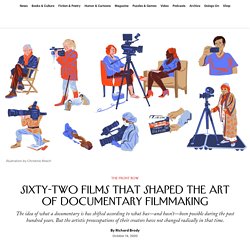

Every Frame a Painting. 62 of the Best Documentaries of All Time. William Greaves’s multilayered metafiction—based on a scripted scene of a couple in crisis—is a documentary about the very nature of fictional films, and the authority of a director trying to make them.

Greaves films himself, his actors, and his crew at work in Central Park, interacting with one another and with whomever happens to be there, and also includes the crew’s own critique of his methods and even his character. “Original Cast Album: Company” (1970, D. A. Pennebaker) In this documentary of the making of a studio recording, Pennebaker captures performances of a historic greatness (especially by Elaine Stritch), filming with a sensitive synergy in long and probing takes that shiver with his own excitement and sense of collaborative energy..
“Numéro Zéro” (1971, Jean Eustache) Eustache’s film consists almost entirely of an extended interview with his grandmother Odette Robert. “Growing Up Female” (1971, Julia Reichert and Jim Klein) “Joyce at 34” (1972, Joyce Chopra and Claudia Weill) Errol Morris: Two Essential Truths About Photography. In this video created by the Guardian, writer and award-winning documentary filmmaker Errol Morris talks about the nature of truth, art, and propaganda in photography.

He draws examples from the photographs of Abu Ghraib and the Crimean War, both cited in his book Believing is Seeing, and he asks the viewer to consider a most fundamental question: how does a photograph relate to the physical world? Unlike a verbal or written statement, a photograph cannot be true or false. It simply is. Then comes another argument worth considering — the idea that all photographs are posed.
UCSB English Broadside Ballad Archive. Culture - How to create an iconic image. What do you think of when you hear the word ‘icon’?
Liz Hurley in that Versace dress? David Bowie? Or perhaps a 12th Century devotional image of a crucified Christ? The truth is, all three of those examples – a famous photograph, a world-renowned musical artist and a piece of religious art – are icons. But the latter is the original; drawn from the Greek word eikōn, meaning ‘image’ or ‘likeness’, these were portrait-style images of important figures like Christ or the Virgin Mary that first appeared in the early centuries of Christianity. But then an image like that of Alaa Salah, protesting in Sudan, captures the global imagination. Break the mould What is it about Alaa Salah and this photograph that has made it so powerful? Dr Tina Rivers Ryan, an art historian and curator specialising in modern and contemporary art, finds that the power lies in Salah’s posture. There are so many symbols in this image that signify a new dawn for the youth in Sudan it’s dizzying. Photography Mapped - Interactive Camera Diagram. Example Was: Street at night Street at night F/Number Was: f/5.6 f/5.6 Shutter Speed Was: 1/60 1/60 Seconds Exposure Meter Was: 0 Technically good exposure In AUTO, settings automatically update to conpensate for lack or abundance of light.

This means the camera will make its best guess of the exposure needed to get the right image brightness. Archival Collection ~ Stock Video & Audio. CONTENTdm. The Ransom Center's movie poster collection consists of an estimated 10,000 posters and spans the entire history of film from the silent era to the present day.

All sizes of American film posters are represented: Window Cards (14" x 22"), Inserts (14" x 36"), Half Sheets (22" x 28"), One Sheets (27" x 41"), Three Sheets (41" x 81"), Six Sheets (81" x81"), and 24 Sheets (i.e.: billboards, 9' x 20.5'). The largest part of the collection comes from the Interstate Theater Circuit.
At one time, the Interstate Theater chain consisted of almost every movie theater in Texas, and the posters, film stills, lobby cards, and press books form the foundation of the Ransom Center's film publicity collection. SCREEN ASIA - Digital resources to support Asia literacy. 6 Things ‘The Room’ Can Teach First-Time Filmmakers.
How Orson Welles' F for Fake Teaches Us How to Make the Perfect Video Essay. If you don't understand what makes Citizen Kane so important, just watch a few movies made before it.

In his first outing as a filmmaker, Orson Welles, whether by ignorance or other virtues, pioneered so many aesthetic and narrative techniques that we can now hardly imagine how the medium ever did without. If you don't understand what makes Welles' last picture, the quasi-documentary on fact and falsehood F for Fake so important, just compare it to all the video essays proliferating on the internet today.
If Citizen Kane was just slightly ahead of its time in 1940, F for Fake, which came out in 1973, now looks more than three decades ahead of the curve. Nobody knows that better than Tony Zhou, creator of the popular cinema-focused video essay series Every Frame a Painting. Video: Learn How to Create a Hyperlapse Clip with Any Camera. 10 Comedic Camera Techniques Every Filmmaker Should Know.